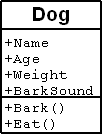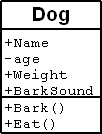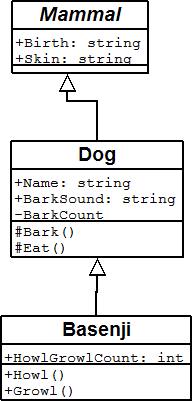Difference between revisions of "OOP Class5"
(→Containment - 'Has A') |
|||
| (71 intermediate revisions by 3 users not shown) | |||
| Line 1: | Line 1: | ||
| − | = | + | [[Category:IAM Classes]] |
| + | ==This keyword== | ||
| − | + | The this keyword used within a class refers to the current instance of the class | |
| − | <csharp>public | + | <syntaxhighlight lang="csharp">public Time( int CurrentYear, int CurrentDay) |
{ | { | ||
| − | + | this.Year = CurrentYear; | |
| − | + | this.Day = CurrentDay; | |
| − | + | }</syntaxhighlight> | |
| − | }</ | ||
| − | |||
| − | |||
| − | |||
| − | |||
| − | |||
| − | |||
| + | ==What is UML== | ||
| + | ;UML : Unified Modeling Language. | ||
| + | :"A modeling language is a language whose vocabulary and rules focus on the conceptual and physical representation of a system" | ||
| + | The Unified Modeling Language User Guide, Booch Rumbaugh Jacobson | ||
| + | ACM Press, Addison Wesley 1999 ISBN 0201571684 | ||
| + | [http://www.amazon.com/gp/product/0201571684/104-7742183-3467114?v=glance&n=283155 The Unified Modeling Language User Guide] | ||
| + | ==Simple Notation== | ||
| + | Class notation in UML | ||
| − | + | The name of the Class should go inside of a box | |
| − | |||
| − | |||
| − | |||
| − | |||
| − | |||
| − | + | {| align="center" cellspacing="0" style="border:2px solid black;" | |
| − | + | |Class Name | |
| + | |} | ||
| − | |||
| − | + | Then Two lines are added. The first line separates Attributes. The second line separates Operations. | |
| − | + | Attributes are the equivalent of fields or properties in c# and Operations are the same as methods. | |
| − | |||
| − | |||
| + | {| align="center" border = 0 | ||
| + | | | ||
| − | + | {| cellspacing="0" style="border:2px solid black;" | |
| + | |Class Name | ||
| + | |- | ||
| + | | style="border-Top:2px solid black;" | | ||
| + | |- | ||
| + | | style="border-Top:2px solid black;" | | ||
| + | |} | ||
| − | + | | | |
| − | |||
| − | + | {| align="center" cellspacing="0" Border = 0 | |
| + | | <--'''Class Name''' | ||
| + | |- | ||
| + | | <--'''Attributes''' | ||
| + | |- | ||
| + | | <--'''Opertaions''' | ||
| + | |} | ||
| − | + | |} | |
| − | { | + | |
| − | + | ||
| + | A Rectagle Class might look like this | ||
| + | |||
| + | {| align="center" cellspacing="0" style="border:2px solid black;" | ||
| + | |Rectangle | ||
| + | |- | ||
| + | | style="border-Top:2px solid black;" | height | ||
| + | |- | ||
| + | | width | ||
| + | |- | ||
| + | | style="border-Top:2px solid black;" | area() | ||
| + | |- | ||
| + | | add() | ||
| + | |- | ||
| + | | move() | ||
| + | |- | ||
| + | | copy() | ||
| + | |- | ||
| + | | isEmpty() | ||
| + | |} | ||
| − | + | You can also specify Attribute types with a : | |
| − | + | {| align="center" cellspacing="0" style="border:2px solid black;" | |
| − | + | |Rectangle | |
| − | + | |- | |
| − | + | | style="border-Top:2px solid black;" | height : Float | |
| − | + | |- | |
| − | + | | width : Float | |
| − | + | |- | |
| − | + | | style="border-Top:2px solid black;" | area() | |
| − | + | |- | |
| − | + | | add() | |
| − | + | |- | |
| − | + | | move() | |
| − | + | |- | |
| + | | copy() | ||
| + | |- | ||
| + | | isEmpty() | ||
| + | |} | ||
| − | + | Default vlaues are specified with = | |
| − | |||
| − | == | + | {| align="center" cellspacing="0" style="border:2px solid black;" |
| − | + | |Rectangle | |
| + | |- | ||
| + | | style="border-Top:2px solid black;" | height : Float = 6.0 | ||
| + | |- | ||
| + | | width : Float = 4.0 | ||
| + | |- | ||
| + | | style="border-Top:2px solid black;" | area() | ||
| + | |- | ||
| + | | add() | ||
| + | |- | ||
| + | | move() | ||
| + | |- | ||
| + | | copy() | ||
| + | |- | ||
| + | | isEmpty() | ||
| + | |} | ||
| − | |||
| − | |||
| − | |||
| − | |||
| + | Operator return type are also specifed with a :. Opertor parameter signatures are specified by ( '''name''' : '''Type''' ) | ||
| − | == | + | {| align="center" cellspacing="0" style="border:2px solid black;" |
| + | |Rectangle | ||
| + | |- | ||
| + | | style="border-Top:2px solid black;" | height : Float = 6.0 | ||
| + | |- | ||
| + | | width : Float = 4.0 | ||
| + | |- | ||
| + | | style="border-Top:2px solid black;" | area() : Float | ||
| + | |- | ||
| + | | add()(r:Rectangle) | ||
| + | |- | ||
| + | | move() | ||
| + | |- | ||
| + | | copy() :Rectangle | ||
| + | |- | ||
| + | | isEmpty() : Boolean = true | ||
| + | |} | ||
| − | A | + | ==UML Resources== |
| + | [http://www.gnome.org/projects/dia/ Dia A Drawing Program] | ||
| − | + | [http://dia-installer.sourceforge.net/ Dia for windows] | |
| − | |||
| − | |||
| − | |||
| − | |||
| − | |||
| − | |||
| − | |||
| − | |||
| − | |||
| − | + | [http://iam.colum.edu/oop/browser/browser.aspx?f=/classsource/class6/DiagramDog Dog Diagrams with Dia] | |
| − | |||
| − | |||
| − | |||
| − | |||
| − | |||
| − | |||
| − | |||
| − | |||
| − | |||
| − | |||
| − | |||
| − | |||
| − | |||
| − | |||
| − | |||
| − | |||
| − | |||
| − | |||
| − | |||
| − | |||
| − | |||
| − | |||
| − | + | ==access-modifiers== | |
| − | + | public + | |
| + | :most permissive access. No restrictions on access | ||
| + | private - | ||
| + | :least permissive access level. Only available to the class in which it was declared | ||
| − | + | Public Dog | |
| − | + | [[Image:DogSimpleUML.png]] | |
| + | Dog with private age | ||
| + | [[Image:DogsimpleAgePrivate.png]] | ||
| − | + | ==Dog Examples== | |
| − | + | Simple Dog Class from week 5 [http://iam.colum.edu/oop/gbrowser.php?file=/classsource/class6/DiagramDog/DogSimple.cs DogSimple.cs - source]<br /> | |
| + | [[Image:DogSimple.png]] | ||
| + | <syntaxhighlight lang="csharp">using System; | ||
| − | + | //Dog simple class definition | |
public class Dog | public class Dog | ||
{ | { | ||
| − | + | public string Name; // the dog's name | |
| − | + | public int Age; // the dog's age | |
| − | + | public int Weight; // the dog's weight | |
| − | + | public string BarkSound; // the sound of the dog's bark | |
| − | + | ||
| − | + | public Dog() | |
| − | + | { | |
| − | + | BarkSound = "Woof!!!"; | |
| − | + | } | |
| + | |||
| + | public void Bark() { | ||
| + | //put bark code here | ||
| + | } | ||
| + | public void Eat() { | ||
| + | //put eat code here | ||
| + | } | ||
| + | }</syntaxhighlight> | ||
| + | |||
| − | + | Dog UML with Types | |
| − | |||
| − | |||
| − | |||
| − | |||
| − | |||
| − | |||
| − | |||
| − | |||
| − | public class | + | Dog Class with Types from week 4 [http://iam.colum.edu/oop/gbrowser.php?file=/classsource/class6/DiagramDog/DogWithTypes.cs DogWithTypes.cs - source]<br /><br /> |
| − | + | [[Image:DogWithTypes.png]] | |
| − | + | <syntaxhighlight lang="csharp">using System; | |
| + | |||
| + | //Dog simple class definition | ||
| + | public class Dog | ||
| + | { | ||
| + | public string Name; // the dog's name | ||
| + | private int age; // the dog's age | ||
| + | public int Weight; // the dog's weight | ||
| + | public string BarkSound; // the sound of the dog's bark | ||
| + | private int barkCount; //The number of time the dog has barked | ||
| + | public Dog() | ||
| + | { | ||
| + | BarkSound = "Woof!!!"; | ||
| + | } | ||
| + | |||
| + | public string Bark() { | ||
| + | string strBark = this.BarkSound; | ||
| + | barkCount ++; | ||
| + | return strBark; | ||
| + | } | ||
| − | + | public void Eat() { | |
| − | + | //put eat code here | |
| − | + | } | |
| − | + | }</syntaxhighlight> | |
| − | |||
| + | ==Class Relationships== | ||
| + | Four Class Relation ships | ||
| − | Containment | + | * Association - ''Uses A'' [[OOP Class6]] |
| − | [ | + | * Containment - ''Has A'' [[OOP Class6]] |
| + | * Inheritance - ''Is A'' | ||
| + | * Interfaces - '''implements or derives from''' We'll do this next week in [[OOP Class7]] | ||
==Inheritance - 'Is A'== | ==Inheritance - 'Is A'== | ||
| Line 168: | Line 226: | ||
C# supports single class inheritance only. Therefore, you can specify only one base class to inherit from. | C# supports single class inheritance only. Therefore, you can specify only one base class to inherit from. | ||
| − | A Basenji is an African barkless dog. | + | '''Sub''' class |
| − | A Basenji is a | + | : a Sub class is a class that inherits properties and methods from another class. The class that sub class inherits from id the '''Super''' class |
| + | '''Super''' class | ||
| + | : a Super class that has other classes that inherit from it. | ||
| + | |||
| + | [[Image:DogInheritance.png|frame|right|caption|The Mammal/Dog/Basengi inheritance relationship]] | ||
| + | |||
| + | A '''Basenji''' is an African barkless dog. | ||
| + | |||
| + | A '''Basenji''' ''is a'' '''Dog'''. | ||
| + | |||
| + | A '''Dog''' ''is a'' '''Mammal'''. | ||
| + | |||
| + | In this case the '''Mammal''' class is the '''Super''' class to the '''Dog'''. | ||
| + | |||
| + | The '''Basenji''' is the '''Sub''' class to the '''Dog''' class. | ||
| + | |||
| + | Here is how you would draw this with UML. | ||
| + | |||
| + | Lets start with the Dog/Basenji Relationship | ||
| + | |||
syntax | syntax | ||
| − | <csharp>public class Basenji : Dog | + | <syntaxhighlight lang="csharp">public class Basenji : Dog |
{ | { | ||
//override constructor | //override constructor | ||
| Line 199: | Line 276: | ||
this.barkCount++ ; | this.barkCount++ ; | ||
} | } | ||
| − | }</ | + | }</syntaxhighlight> |
| − | [http://iam.colum.edu/oop/gbrowser.php?file=/classsource/class5/ | + | [http://iam.colum.edu/oop/gbrowser.php?file=/classsource/class5/BasenjiInhertance.cs BasenjiInhertance.cs] -source |
==Virtual Functions== | ==Virtual Functions== | ||
A class modifier that indicates that a method can be overridden by a derived class. | A class modifier that indicates that a method can be overridden by a derived class. | ||
| − | + | ||
| + | By marking a function as '''virtual''' any class a class that sub classes the current class can '''override''' the function | ||
==Abstract Classes== | ==Abstract Classes== | ||
abstract - A class modifier that specifies that the class must be derived from to be instantiated. | abstract - A class modifier that specifies that the class must be derived from to be instantiated. | ||
| − | <csharp>abstract public class Mammal | + | <syntaxhighlight lang="csharp">abstract public class Mammal |
{ | { | ||
| − | + | public string Birth; | |
| − | + | public string Skin; | |
public Mammal() | public Mammal() | ||
{ | { | ||
| − | + | Birth = " gives birth to live young."; | |
| − | + | Skin = " has Hair."; | |
} | } | ||
| + | }</syntaxhighlight> | ||
| + | |||
| + | Inheritance example /infod/jeff/classSource/class5/DogMammalInhertance.cs -source | ||
| + | |||
| + | ===Polymorphic Types=== | ||
| + | |||
| + | ;Polymorphism: poly means 'many' morph means 'form'. So a polymorphic type is many forms that have the same attributes and abilities | ||
| + | |||
| + | [http://en.wikipedia.org/wiki/Polymorphism_%28computer_science%29 Polymorphism (computer science)] | ||
| − | + | Different types implementing the same functionality. | |
| − | |||
| − | |||
| − | |||
| − | |||
| − | |||
| − | |||
| − | |||
| − | |||
| − | |||
| − | |||
| − | |||
| − | |||
| − | |||
| − | |||
| − | + | [http://www.webopedia.com/TERM/p/polymorphism.html polymorphism webopedia] | |
| − | + | The C# Station Tutorial - [http://www.csharp-station.com/Tutorials/Lesson09.aspx Lesson 9: Polymorphism] | |
| − | The C# Station Tutorial - Lesson 9: Polymorphism | ||
| − | <csharp>abstract public class Mammal | + | <syntaxhighlight lang="csharp">//Mammal class definition is it abstract |
| + | abstract public class Mammal | ||
{ | { | ||
| − | + | public string Name; | |
| − | + | public string Brith; | |
| − | + | public string Skin; | |
public Mammal() | public Mammal() | ||
{ | { | ||
| − | + | Name = "none"; | |
| − | + | Brith = " gives Brith to live young."; | |
| − | + | Skin = " has Hair."; | |
} | } | ||
| + | |||
public Mammal(string newName) | public Mammal(string newName) | ||
{ | { | ||
| − | + | Name = newName; | |
| − | + | Brith = " gives Brith to live young."; | |
| − | + | Skin = " has Hair."; | |
} | } | ||
| − | |||
| − | |||
| − | |||
| − | |||
| − | |||
| − | |||
| − | |||
| − | |||
| − | |||
| − | |||
| − | |||
| − | |||
| − | |||
| − | |||
| − | |||
| − | |||
| − | |||
| − | |||
| − | |||
| − | |||
| − | |||
| − | |||
| − | |||
| − | |||
| − | |||
public virtual void Bark() | public virtual void Bark() | ||
{ | { | ||
Console.WriteLine("Some Mammals Bark."); | Console.WriteLine("Some Mammals Bark."); | ||
} | } | ||
| + | |||
} | } | ||
| + | //Dog simple class definition | ||
public class Dog : Mammal | public class Dog : Mammal | ||
{ | { | ||
| Line 313: | Line 364: | ||
} | } | ||
| + | //a basengi is a barkless dog | ||
public class Basenji : Dog | public class Basenji : Dog | ||
{ | { | ||
| Line 326: | Line 378: | ||
Console.WriteLine("\nBasenjis dont bark."); | Console.WriteLine("\nBasenjis dont bark."); | ||
} | } | ||
| − | + | ||
| − | }</ | + | // some more code.... |
| + | } | ||
| + | |||
| + | }</syntaxhighlight> | ||
[http://iam.colum.edu/oop/gbrowser.php?file=/classsource/class5/DogPoly.cs DogPoly.cs] -source | [http://iam.colum.edu/oop/gbrowser.php?file=/classsource/class5/DogPoly.cs DogPoly.cs] -source | ||
| − | == | + | ==HomeWork== |
| − | + | '''READ''' | |
| − | + | #Chapter 9 Inside Methods p 111-123 | |
| − | + | #Chapter 11 Inheritance and Polymorphism p 134-154 | |
| − | + | #Chpater 12 Operator Overloading p 155 - 172 | |
| − | |||
| − | |||
| − | |||
| − | |||
| − | |||
| − | |||
| − | |||
| − | |||
| − | |||
| − | |||
| − | |||
| − | |||
| − | |||
| − | |||
| − | |||
| − | |||
| − | |||
| − | |||
| − | |||
| − | |||
| − | |||
| − | |||
| − | |||
| − | |||
| − | |||
| − | |||
| − | |||
| − | + | '''DO''' | |
| − | + | Create a super class and a sub class for your class.<br /> | |
| − | + | http://iam.colum.edu/oop/classsource/class5/ConsoleApplicationInClass.zip | |
| − | |||
| − | |||
| − | + | New One | |
| − | + | http://iam.colum.edu/oop/classsource/class5/ConsoleApplicationInClass5.zip | |
| − | |||
==Links== | ==Links== | ||
| − | The C# Station Tutorial - Lesson 7: Introduction to Classes | + | [http://www.csharp-station.com/Tutorials/Lesson07.aspx The C# Station Tutorial - Lesson 7: Introduction to Classes]<br> |
| − | The C# Station Tutorial - | + | [http://www.csharp-station.com/Tutorials/Lesson08.aspx The C# Station Tutorial - Lesson 8: Class Inheritance]<br> |
| − | The C# Station Tutorial - Lesson 9: Polymorphism | + | [http://www.csharp-station.com/Tutorials/Lesson09.aspx The C# Station Tutorial - Lesson 9: Polymorphism]<br> |
| − | The C# Station Tutorial - Lesson 10: Properties | + | [http://www.csharp-station.com/Tutorials/Lesson10.aspx The C# Station Tutorial - Lesson 10: Properties]<br> |
| − | The C# Station Tutorial - Lesson 12: Structs | + | [http://www.csharp-station.com/Tutorials/Lesson12.aspx The C# Station Tutorial - Lesson 12: Structs]<br> |
| − | The C# Station Tutorial - Lesson 13: Interfaces | + | [http://www.csharp-station.com/Tutorials/Lesson13.aspx The C# Station Tutorial - Lesson 13: Interfaces]<br> |
| − | C# | + | [http://www.csharp-station.com/Tutorials/Lesson04.aspx The C# Station Tutorial - Lesson 4: C# Fundamentals] |
Latest revision as of 16:30, 10 June 2019
Contents
This keyword
The this keyword used within a class refers to the current instance of the class
public Time( int CurrentYear, int CurrentDay)
{
this.Year = CurrentYear;
this.Day = CurrentDay;
}
What is UML
- UML
- Unified Modeling Language.
- "A modeling language is a language whose vocabulary and rules focus on the conceptual and physical representation of a system"
The Unified Modeling Language User Guide, Booch Rumbaugh Jacobson ACM Press, Addison Wesley 1999 ISBN 0201571684 The Unified Modeling Language User Guide
Simple Notation
Class notation in UML
The name of the Class should go inside of a box
| Class Name |
Then Two lines are added. The first line separates Attributes. The second line separates Operations.
Attributes are the equivalent of fields or properties in c# and Operations are the same as methods.
|
|
A Rectagle Class might look like this
| Rectangle |
| height |
| width |
| area() |
| add() |
| move() |
| copy() |
| isEmpty() |
You can also specify Attribute types with a :
| Rectangle |
| height : Float |
| width : Float |
| area() |
| add() |
| move() |
| copy() |
| isEmpty() |
Default vlaues are specified with =
| Rectangle |
| height : Float = 6.0 |
| width : Float = 4.0 |
| area() |
| add() |
| move() |
| copy() |
| isEmpty() |
Operator return type are also specifed with a :. Opertor parameter signatures are specified by ( name : Type )
| Rectangle |
| height : Float = 6.0 |
| width : Float = 4.0 |
| area() : Float |
| add()(r:Rectangle) |
| move() |
| copy() :Rectangle |
| isEmpty() : Boolean = true |
UML Resources
access-modifiers
public +
- most permissive access. No restrictions on access
private -
- least permissive access level. Only available to the class in which it was declared
Dog Examples
Simple Dog Class from week 5 DogSimple.cs - source
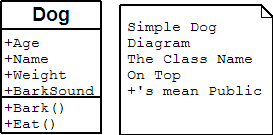
using System;
//Dog simple class definition
public class Dog
{
public string Name; // the dog's name
public int Age; // the dog's age
public int Weight; // the dog's weight
public string BarkSound; // the sound of the dog's bark
public Dog()
{
BarkSound = "Woof!!!";
}
public void Bark() {
//put bark code here
}
public void Eat() {
//put eat code here
}
}
Dog UML with Types
Dog Class with Types from week 4 DogWithTypes.cs - source
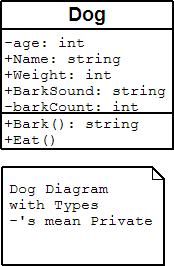
using System;
//Dog simple class definition
public class Dog
{
public string Name; // the dog's name
private int age; // the dog's age
public int Weight; // the dog's weight
public string BarkSound; // the sound of the dog's bark
private int barkCount; //The number of time the dog has barked
public Dog()
{
BarkSound = "Woof!!!";
}
public string Bark() {
string strBark = this.BarkSound;
barkCount ++;
return strBark;
}
public void Eat() {
//put eat code here
}
}
Class Relationships
Four Class Relation ships
- Association - Uses A OOP Class6
- Containment - Has A OOP Class6
- Inheritance - Is A
- Interfaces - implements or derives from We'll do this next week in OOP Class7
Inheritance - 'Is A'
C# supports single class inheritance only. Therefore, you can specify only one base class to inherit from.
Sub class
- a Sub class is a class that inherits properties and methods from another class. The class that sub class inherits from id the Super class
Super class
- a Super class that has other classes that inherit from it.
A Basenji is an African barkless dog.
A Basenji is a Dog.
A Dog is a Mammal.
In this case the Mammal class is the Super class to the Dog.
The Basenji is the Sub class to the Dog class.
Here is how you would draw this with UML.
Lets start with the Dog/Basenji Relationship
syntax
public class Basenji : Dog
{
//override constructor
public Basenji() : base()
{
barkSound = "Basenjis don't bark, but they do howl and growl.";
dogCount++;
}
public override void Bark()
{
Console.WriteLine("Basenjis dont bark.");
}
// some more code....
}
public class Dog
{
// some dog code...
//methods need to be marked virtual or protected to be overridden
public virtual void Bark()
{
//make dog bark
Console.WriteLine (this.Name + " says " + this.barkSound);
//add 1 to the number of times the dog has barked
this.barkCount++ ;
}
}
BasenjiInhertance.cs -source
Virtual Functions
A class modifier that indicates that a method can be overridden by a derived class.
By marking a function as virtual any class a class that sub classes the current class can override the function
Abstract Classes
abstract - A class modifier that specifies that the class must be derived from to be instantiated.
abstract public class Mammal
{
public string Birth;
public string Skin;
public Mammal()
{
Birth = " gives birth to live young.";
Skin = " has Hair.";
}
}
Inheritance example /infod/jeff/classSource/class5/DogMammalInhertance.cs -source
Polymorphic Types
- Polymorphism
- poly means 'many' morph means 'form'. So a polymorphic type is many forms that have the same attributes and abilities
Polymorphism (computer science)
Different types implementing the same functionality.
The C# Station Tutorial - Lesson 9: Polymorphism
//Mammal class definition is it abstract
abstract public class Mammal
{
public string Name;
public string Brith;
public string Skin;
public Mammal()
{
Name = "none";
Brith = " gives Brith to live young.";
Skin = " has Hair.";
}
public Mammal(string newName)
{
Name = newName;
Brith = " gives Brith to live young.";
Skin = " has Hair.";
}
public virtual void Bark()
{
Console.WriteLine("Some Mammals Bark.");
}
}
//Dog simple class definition
public class Dog : Mammal
{
public string BarkSound; // the sound of the dog's bark
public Dog(string newName)
{
Name = newName;
BarkSound = "Woof!!!";
}
public override void Bark() {
base.Bark();
Console.WriteLine(this.Name + " says " + this.BarkSound);
}
public void Eat() {
//put eat code here
}
}
//a basengi is a barkless dog
public class Basenji : Dog
{
//override constructor
public Basenji(string newName) : base(newName)
{
BarkSound = "basenjis don't bark, but they do howl and growl.";
}
public override void Bark()
{
base.Bark();
Console.WriteLine("\nBasenjis dont bark.");
}
// some more code....
}
}
DogPoly.cs -source
HomeWork
READ
- Chapter 9 Inside Methods p 111-123
- Chapter 11 Inheritance and Polymorphism p 134-154
- Chpater 12 Operator Overloading p 155 - 172
DO
Create a super class and a sub class for your class.
http://iam.colum.edu/oop/classsource/class5/ConsoleApplicationInClass.zip
New One http://iam.colum.edu/oop/classsource/class5/ConsoleApplicationInClass5.zip
Links
The C# Station Tutorial - Lesson 7: Introduction to Classes
The C# Station Tutorial - Lesson 8: Class Inheritance
The C# Station Tutorial - Lesson 9: Polymorphism
The C# Station Tutorial - Lesson 10: Properties
The C# Station Tutorial - Lesson 12: Structs
The C# Station Tutorial - Lesson 13: Interfaces
The C# Station Tutorial - Lesson 4: C# Fundamentals
